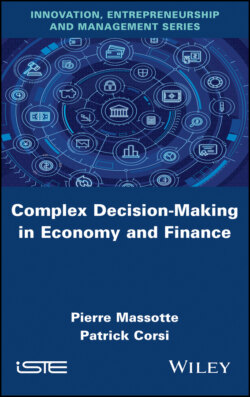Читать книгу Complex Decision-Making in Economy and Finance - Pierre Massotte - Страница 57
2.2.1. Emergence of self-organized patterns
ОглавлениеA concrete structure corresponds to a system’s stable state, i.e. a particular organization. Self-organization allows the transition, in an autonomous and reactive way, from one stable structure to another. The stability of a system’s structure depends on how long it remains stable despite disruptions that tend to destabilize it. Self-organization sometimes highlights phenomena of convergence towards particular structures. In this sense, it uses the concepts of attractors and basins of attraction, as defined in the chaos theory. This can be illustrated as follows:
– a social organization is highly dependent on the nature of the problem being solved; it is contextual. In other words, an organization may be adequate to solve one problem but may be inadequate for another. We consider that a system adapts if, in the face of a situation not foreseen by the designer of the final application, it does not block itself but reacts by being able to modify its functions and structure on its own initiative in order to achieve the desired purpose. In this context, we need systems that are adaptable and have a learning capacity. In other words, the system can change its behavior in response to changes in its environment without drawing lasting consequences. We consider that a multi-agent system learns if it modifies its protocol over time, as well as if each agent in this system can modify its skills, beliefs and social attitudes according to the current moment and past experience. The system that learns to organize itself according to past experience makes it possible to arrive more quickly at the optimum that is the best organization responding to the problem at hand. It belongs here to the class of systems that we will call “reactive”;
– programmable networks have communication functions between the actual network processing nodes. These networks (often of the Hopfield type) have an evolution that tends to bring them closer to a stable state through successive iterations. This is dynamic relaxation; it depends on an energy function, similar to that of Ising’s spin glasses [WIL 83], decreasing towards a local minimum. It is then said that the system evolves in a basin of attraction and converges towards an attractor whose trajectory depends on the context and its environment. This analogy with statistical physics (genetic algorithm, with its particular case, among others, simulated annealing) makes it possible to recover certain results, and to solve many allocation and optimization problems;
– in a distributed production system, we are not faced with a scheduling problem, but with a problem involving configuration and reconfiguration of means and resources. The aim is therefore to highlight the self-organizing properties of these networks and to show how they converge towards stable, attractive states or orders in a given phase and state space. Thus, distributed production systems subject to disruptive conditions or moved to neighboring states will converge to the same stable state. This allows classifications to be made, for example, the automatic reconfiguration of a production system (allocation of resources and means) according to a context;
– the same is true in logistics, with the possibility of organizing a round of distribution in terms of means of transport where the optimization of the route also requires these techniques;
– in the field of Information Technology, IT systems can be dynamically reorganized to deal with problems that can evolve over time without the intervention of an external operator. Such a system could be adapted to the current context, and therefore to possible disruptions, through learning (supervised, unsupervised, reinforced, etc.).
In conclusion, a system with the capacity for self-organization has several states of equilibrium, i.e. particular organizations. Each particular organization is characterized by a set of different initial conditions that, when verified, converge the system to a corresponding stable organization. Most of the time, the self-organization system is between one or the other of its equilibrium states at the end of a time cycle that can be determined. It moves from one organizational state to another under the disorganizing pressure of its environment. The system that can adapt to changing circumstances by modifying the interaction structures between its components has the potential to achieve some consistency in environments with a high degree of uncertainty or change.
